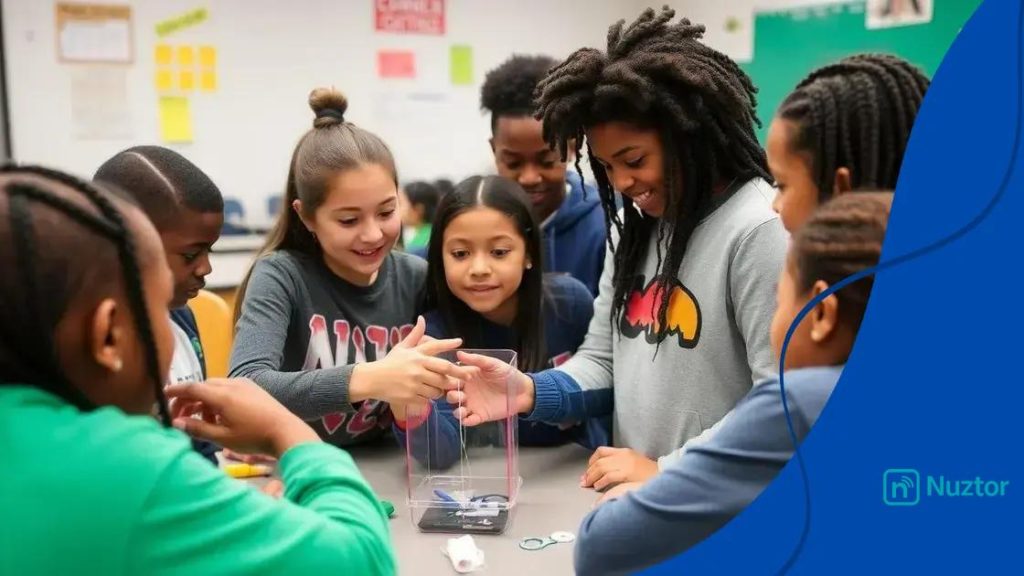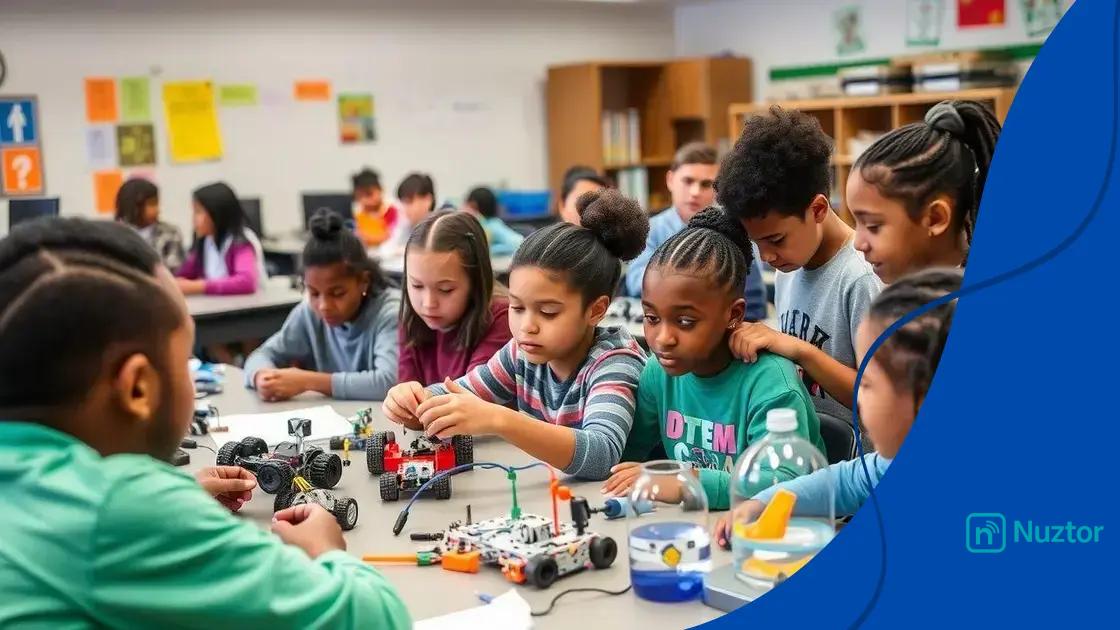STEM education initiatives for a brighter future

STEM education initiatives enhance learning by promoting hands-on experiences, collaboration, and the integration of technology, preparing students for future careers in science, technology, engineering, and mathematics.
STEM education initiatives are transforming how students engage with science, technology, engineering, and mathematics. They encourage creativity and critical thinking while preparing the next generation for exciting careers. Curious about how these initiatives affect education? Let’s dive in!
Understanding the importance of STEM education
Understanding the importance of STEM education is crucial for our future. These fields—science, technology, engineering, and mathematics—play a pivotal role in shaping innovative thinkers. They equip students with the skills necessary to solve real-world problems, nurturing a generation that can tackle future challenges.
The Role of STEM in Developing Skills
STEM education helps develop critical skills such as problem-solving, analytical thinking, and creativity. These skills are not only essential for careers in STEM fields but are also valuable in everyday life.
- Encourages critical thinking
- Enhances problem-solving abilities
- Stimulates innovation and creativity
Moreover, STEM education fosters collaboration and communication among students. Working on group projects helps them learn how to express ideas and listen to others, creating a more inclusive environment.
Impact on Career Choices
As students engage with STEM education, they become more aware of various career choices available to them. They can explore professions such as engineering, computer science, and healthcare. This exploration is vital, as it opens doors to future opportunities.
Additionally, exposure to STEM initiatives can spark a passion for these fields at an early age. Students often find inspiration in hands-on projects that make learning interactive and fun. By participating in STEM programs, students not only gain knowledge but also develop a love for learning that can last a lifetime.
Overall, understanding the importance of STEM education is essential for both students and communities. It encourages a mindset geared towards growth and innovation, preparing the next generation for a world that increasingly relies on technology and science.
Key components of successful STEM initiatives
Key components of successful STEM initiatives are essential for enhancing student engagement and improving educational outcomes. These components ensure that programs are effective and relevant, providing students with the tools they need for future success.
Collaborative Learning Environments
One important aspect is fostering collaborative learning environments. When students work together, they can share ideas and solve problems more creatively. Partnerships among educators, industry professionals, and community members also enhance these initiatives.
- Encourages teamwork and communication
- Builds real-world connections
- Promotes diverse perspectives
In addition to collaboration, offering hands-on experiences is crucial. Activities such as labs, experiments, and real-world projects allow students to apply what they learn in the classroom. This experiential learning deepens understanding and makes lessons more memorable.
Curriculum Relevance
Another key component is ensuring that the curriculum is relevant and aligned with current trends. It’s important that students learn skills that are in demand in today’s job market. Integrating technology and innovative practices helps to keep the curriculum engaging and applicable.
Furthermore, mentorship programs can greatly enhance STEM initiatives. Having role models and guides for students not only provides support but also inspires them to pursue careers in STEM fields. Strong mentorship can steer students towards opportunities they may not have considered.
Equally important is continuous assessment and feedback. Regular evaluations enable educators to adjust the programs based on student needs, making the STEM initiatives more effective. Understanding what works and what doesn’t allows for improvements that benefit all students.
Real-world examples of effective STEM programs

Real-world examples of effective STEM programs showcase how engaging activities can lead to greater student interest and achievement. Across the globe, innovative initiatives illustrate the impact of hands-on learning.
STEM Education at the Smithsonian
The Smithsonian Institution offers a range of programs designed to inspire students. Through its STEM education initiatives, students explore science in exciting ways. Programs like the Smithsonian Science for the Classroom integrate hands-on experiments with real-world applications, making subjects come alive.
- Students interact with scientists and experts
- Real-life data is used for projects
- Field trips to museums enhance learning
Another notable example is the FIRST Robotics Competition. This program allows students to design and build robots, merging engineering and technology in a fun, competitive environment. It emphasizes teamwork and problem-solving while participants tackle real engineering challenges.
Local Initiatives and Community Engagement
Many local initiatives have also proved successful. Programs like after-school STEM clubs encourage hands-on activities that keep students engaged. These clubs often focus on coding, robotics, and environmental science, attracting diverse groups of students who might not otherwise pursue STEM fields.
Partnerships with local businesses can enhance the effectiveness of these programs. For example, community members might offer mentorship or internships, providing students valuable experiences in real-world settings. Such collaborations foster a sense of belonging and encourage students to envision careers in STEM.
Furthermore, initiatives like Girls Who Code aim to empower young women to enter the tech field. Through coding workshops and supportive networks, these programs create a welcoming space where girls can develop essential skills and gain confidence to explore technology careers.
How to support STEM education in your community
Supporting STEM education in your community can make a significant difference in students’ lives. There are many ways individuals and organizations can get involved to foster a love for science, technology, engineering, and mathematics.
Volunteer Your Time
One effective way to support STEM education is by volunteering. Mentors can inspire students by sharing their own experiences and knowledge. Consider reaching out to local schools or community centers to find opportunities to assist with STEM programs.
- Lead a workshop on a specific STEM topic
- Assist with after-school programs
- Participate in science fairs as a judge or mentor
Another great method is to donate resources. Schools often need supplies for hands-on projects. You can help by providing materials such as science kits, crafting tools, or technology like computers and software.
Form Partnerships with Local Businesses
Collaboration with local businesses can greatly enhance STEM initiatives. Business owners can sponsor events, provide guest speakers, or offer internships for students interested in pursuing careers in STEM fields.
Hosting community events is also an effective way to promote STEM education. Organize science nights, coding boot camps, or engineering competitions to engage the local youth. These events can spark interest and excitement in various subjects.
Finally, advocating for STEM funding in local schools is crucial. Attend school board meetings and speak up for the importance of investing in STEM programs. Your voice can help ensure that school curricula include vital STEM learning opportunities.
Future trends in STEM education initiatives
Future trends in STEM education initiatives are shaping the way students learn and prepare for their careers. As technology evolves, so do the methods used in classrooms, making education more engaging and relevant.
Incorporating Artificial Intelligence
One significant trend is the incorporation of artificial intelligence into STEM education. AI can offer personalized learning experiences for students, adapting resources and teaching styles to fit individual needs. This technology helps educators identify students’ strengths and areas for improvement, ensuring everyone gets the help they need.
- Customized learning plans based on student performance
- Automated feedback on assignments
- AI-driven tutoring programs supporting students after school
Another major focus is on hands-on learning through virtual and augmented reality. These technologies immerse students in experiences that were once only possible in the real world. For instance, students can explore distant planets or observe complex biological processes up close, enhancing their understanding of challenging concepts.
Emphasis on Interdisciplinary Learning
Additionally, there is a growing emphasis on interdisciplinary learning. Connecting subjects like math, science, and art fosters creativity and critical thinking. Schools are beginning to create integrated projects that allow students to draw knowledge from multiple disciplines to solve problems.
Collaboration between schools and industries will become even more important. Companies are increasingly engaging with educational institutions to provide real-world challenges for students to tackle. These partnerships not only prepare students for future careers but also ensure their skills meet industry needs.
Lastly, the focus on inclusivity in STEM education initiatives is set to expand. Programs targeting underrepresented groups aim to bridge gaps in access and participation, ensuring all students can thrive in STEM fields. This trend encourages diverse perspectives, which is crucial for innovation.
In summary, supporting STEM education initiatives is essential for fostering innovation and equipping future generations with the skills they need. By promoting collaboration, hands-on learning, and inclusivity, we can create an environment where every student can thrive. The future of STEM education looks bright as more communities come together to invest in the education of their youth.
FAQ – Frequently Asked Questions about STEM Education Initiatives
What are STEM education initiatives?
STEM education initiatives focus on enhancing learning in science, technology, engineering, and mathematics through engaging and hands-on approaches.
How can I support STEM education in my community?
You can support by volunteering, donating resources, or partnering with local businesses to promote STEM programs.
What future trends are emerging in STEM education?
Emerging trends include the use of artificial intelligence, virtual reality, and a greater emphasis on interdisciplinary learning.
Why is hands-on learning important in STEM education?
Hands-on learning helps students apply concepts in real-world situations, increasing engagement and retention of knowledge.